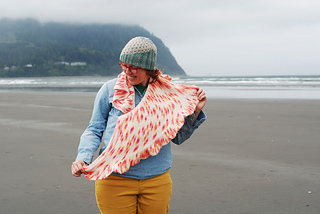patterns >  Lee's Ravelry Store and 2 more...
Lee's Ravelry Store and 2 more...
> Flit



























Flit
Flit involves a fun stitch pattern that’s based on when your variegated yarn color changes. This pattern is written for two different weight/gauge options, with notes for using any other weight/gauge. Use any yarn you want as long as the colorway will work! (See yarn notes below.)
When I held this yarn in my hands I knew I wanted to design something that would make best use of the unusual dye-job, a couple of splotches of colors with the majority left un-dyed. I’ve always been interested in the idea of randomness in knitting, using things like the colorway itself to determine what happens in the knitting/fabric, and this seemed like the perfect yarn for that kind of playing.
So I came up with a stitch pattern which shows off the colors, and at the same time creates a sort-of-randomized textured fabric based on the yarn. As a bonus, this kind of playful patterning makes the knitting itself so much fun to do!
You need
1–2 skeins of variegated yarn (see yarn notes for colorway requirements), or more for a longer length, fingering weight or DK weight to match the samples, or any weight
-- small sample used 1 skein of Blue Moon Fiber Arts® Socks that Rock® lightweight fingering weight yarn in a club-exclusive Tipsy Clan colorway (use any Tipsy colorway) 405 yards / 370 meters
-- large sample used 2 skeins of Blue Moon Fiber Arts® La Luna DK yarn in the Delilah Dixie Tipsy colorway, 440 yards / 402 meters total
- Needles sized to get gauge or match yarn, for knitting flat; small sample used size US 2 (2.75mm); large sample used size US 5 (3.75mm)
Gauge
Fingering weight sample gauge is 26 stitches per 4 inches; DK weight sample gauge is 19 stitches per 4 inches; both in stockinette stitch. Exact gauge is not important, as fit isn’t an issue with this accessory.
This piece can be made in different sizes and/or with different yarn weights, by changing the cast-on number and stopping whenever you like the length. If you use a different weight, your gauge should be a good standard gauge for that yarn, not loose.
Yarn
The stitch pattern is completely dependent on the colorway of your yarn—you must use a variegated yarn with one color selected as the “contrasting color” which is dyed on no more than a fourth of the yarn. The contrasting color is best in segments of around 5–12 inches / 12–30 cm long, with longer segments of the “main color” between the contrasting segments.
The main color can be one solid color, like the white in the sample pieces, or it can be made up of more than one color, but the color designated as the contrasting color should pop off the yarn and be clearly contrasting with the main color(s). For example, a 3-color variegated yarn with shades of blue and green labeled as the main color, and a bright yellow labeled as the contrasting color should work out nicely, as the yellow will pop off the blue/green.
For your project to look like the sample pieces, the contrasting color should be on approx 20% of the yarn, divided into 2 segments of approx 7 inches / 18 cm each, on a loop of yarn with a total circumference of approx 72 inches / 183 cm. (See the photo with measurements noted.) It can be quite a bit different from this and still work, but your stitch pattern will look different from the sample. You can, of course, try out any kind of yarn for a few inches and see if it works out.
A version of this pattern was originally released in July 2016 only to Blue Moon Fiber Arts Rockin’ Sock Club members.
43350 projects
stashed
56920 times
49 projects
stashed
102 times
- First published: July 2018
- Page created: August 5, 2016
- Last updated: July 17, 2024 …
- visits in the last 24 hours
- visitors right now





